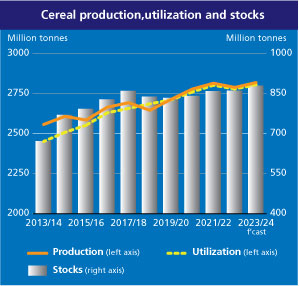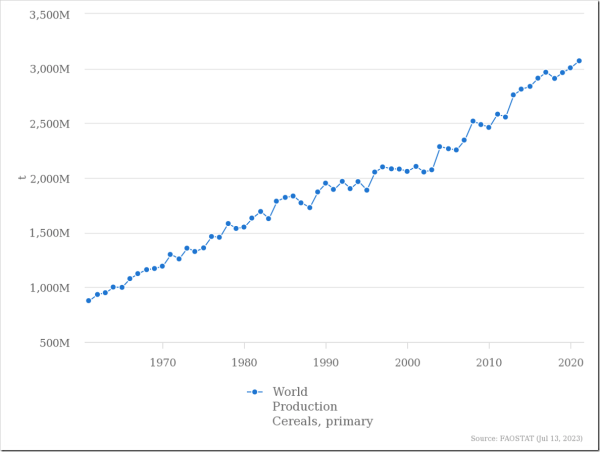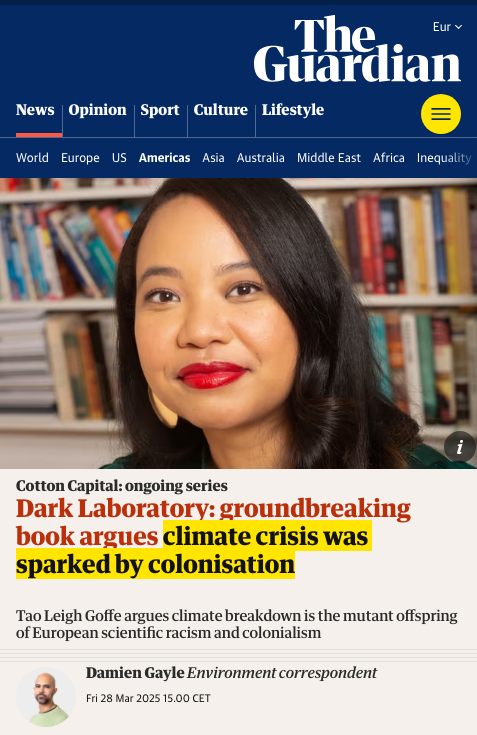By Paul Homewood
Over 122 million more people are now facing hunger than in 2019, according to a United Nations report, which says the war in Ukraine and Covid-19 pandemic have had a devastating effect on food supplies.
In total, between 691 and 783 million people went hungry in 2022, the UN’s latest State of Food Security and Nutrition in the World report found.
It said that global food insecurity has worsened in recent years due to a “perfect storm” of Covid-19, extreme weather events and ongoing conflicts, with Russia’s invasion of Ukraine, and its blockade of the port of Odesa, exposing the world’s dependence on Black Sea grain and sunflower oil imports.
Nearly 2.4 billion people, equivalent to 29.6 per cent of the global population, did not have constant access to food in 2022, according to the report. One in five people faced hunger in Africa, more than twice the global average.
.
However these claims are directly contradicted by the UN’s own food production data, which shows a steady increase in both cereal production and overall agricultural output, culminating in record outputs in 2021:
https://www.fao.org/faostat/en/#compare
.
No data has been published for last year yet, but UN data also shows that global cereal output in 2022, though slightly down on the year before, was still the second highest on record:

https://www.fao.org/worldfoodsituation/csdb/en/
.
And despite the floods last year, or maybe because of them, even Pakistan has just announced a record-breaking wheat harvest this spring:
.
https://www.rferl.org/a/pakistan-food-insecurity-record-breaking-wheat-harvest/32397280.html
.
So how does the UN reconcile its hunger claims against a backdrop of increasing food production?
The UN’s report mentions two measures:
1) Undernourishment
2) Food insecurity
.
Undernourishment
Our World in Data describe the UN’s methodology:
To judge whether someone was undernourished we would need to know two things:
- How many calories they consume;
- How many calories they need to maintain a healthy life.
This might be easy for a known individual, but measuring this across a whole population is more difficult.
The amount of calories that people need can be very different: factors such as someone’s height, weight, sex, age, and activity levels will mean that some people need more calories than others.
The amount of calories that people consume also varies widely – some people eat more than their requirements – which can lead to obesity – while others eat well below their requirements.
This means we cannot simply calculate undernourishment from an average of calorie consumption and requirements.
To take account of this, the UN FAO address inequalities using three factors: 1:
- They estimate the average availability of calories (energy) across the population.
- They measure the levels of inequalities in food consumption within a population. This is called the Coefficient of Variation (CV) of energy intake. This metric is shown in the map. As we see, this value varies from country to country depending on the inequalities in food supply.
- They use demographic information – such as age structure, sex, height, and activity levels – for each country to assess the distribution of energy requirements. This means the ‘minimum energy requirement’ for each country is slightly different, as shown on the map.
Using these three factors, they then calculate undernourishment using a ‘parametric probability density function’. This indicates the cumulative probability across a population that someone has a daily energy intake that is lower than the minimum requirements.
https://ourworldindata.org/undernourishment-definition
.
In short the index tells us little about overall food availability in a country, and more about the inequalities of income etc. Moreover, the methodology is highly subjective, to the point of being virtually useless, not least because we know that far fewer live under extreme poverty than in the past:
.
Food Insecurity
The methodology behind the calculation of this is even more suspect. Again, Our World in Data explain:
Food insecurity is one of the major causes of poor nutrition.
Food insecurity can be caused by several factors: food might be physically unavailable in a particular country or region; it can be unaffordable even if it is available to buy; or there might be an unequal distribution of food between household members.
Food insecurity is measured by the FAO using its Food Insecurity Experience Scale (FIES) global reference scale.
Food insecurity can be based on how having enough food (the quantity) or having inadequate quality and diversity of food. Someone might get enough food to meet their energy requirements, but they might rely on only a few basic foods (such as cereals) and have a diet with very little diversity.
The FIES measures the share of the population that has experienced food insecurity at moderate or severe levels during the period of measurement. Data is collected at the household level using a food security questionnaire. This survey asks households about a number of conditions that someone with food insecurity would typically experience.
It’s based on eight questions (the full list is given at the end of this article), such as:
“During the last 12 months, was there a time when you (or any other adult in the household) were worried you would not have enough food to eat because of a lack of money or other resources?”.
And:
“Was there a time when you (or any other adult in the household) had to skip a meal because there was not enough money or other resources to get food?”
These eight questions increase in severity: the first question is about worrying that you might not have enough food to eat at some point over the year. This evolves to actually eating less than is sufficient, then finally to going a whole day or more without any food.
https://ourworldindata.org/food-insecurity
.
In short, the UN’s claims are not based on actual data, but are derived from household surveys!
Regardless of the issues of inequality, it is abundantly clear that any increases in hunger have nothing to do with lower food production, which makes the statement made by the UN’s Division Director, reported by the Telegraph, utterly mendacious:
David Laborde, Division Director of the Food and Agriculture Organization of the UN, told the Telegraph that the war in Ukraine must be seen in the context of existing global crises – including the pandemic, conflict in Ethiopia and Yemen, and extreme weather events.
“It is a combination of shock. Ukraine is a tragedy, but it also happened at a time when the system was particularly vulnerable,” he said. “We are talking about the pandemic and the global economy stopping as we have never seen.”
Mr Laborde added that the report is the “wake-up call we need”.
He warned that although food systems have not entirely collapsed in the face of these global challenges, there is no promise that they will hold in the future.
“Despite all the shock that has hit all our food systems, the systems are still there,” he said.
“The system has not collapsed, but this does mean that it’s going to take much more. We cannot rely anymore on luck.”
.
To suggest that the world’s food supply is on the verge of collapse is an outright lie, given record amounts are being produced.
It is sad to see a once serious newspaper descend to publishing UN propaganda, with no attempt to do any factchecking first.
.








